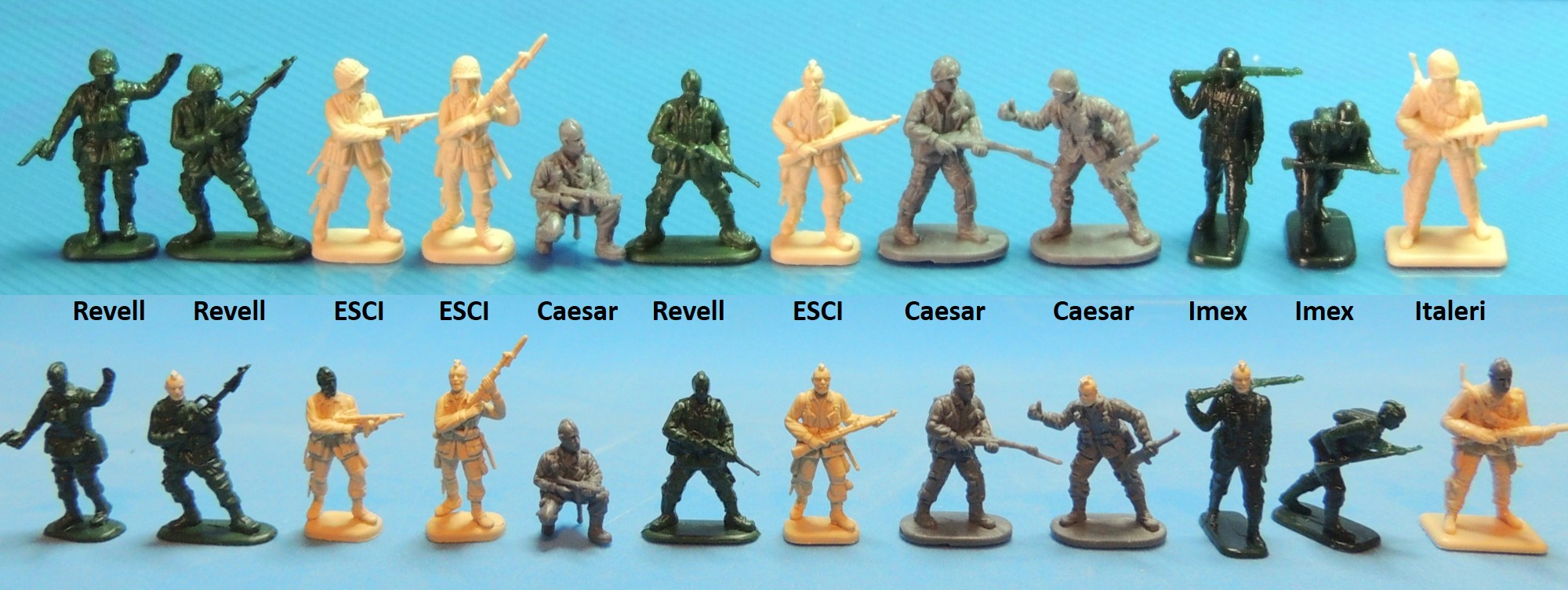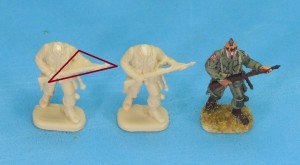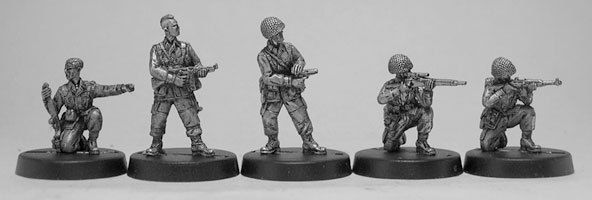This is the third of a five-part series on the Filthy Thirteen. For a synopsis of these colorful characters and creating the figures in 1/72 scale, please refer to the two previous posts, The Filthy Thirteen, Part 1 and Part 2.
U.S. Army Airborne Weapons
The nature of U.S. Airborne troops in WWII was such that their weapons had to be specialized, usually to make them lighter or more portable. Because paratroopers were often dropped behind enemy lines where resupply was uncertain, they had to schlep loads of 100 lbs. or more on their backs, making lighter, more portable weapons a must.
As I mentioned in Part 2, one of my goals was for the 1/72 scale unit to reflect as many of the weapons used by U.S. paratroopers as possible. I compiled the weapons plate below from a number of illustrations contained in various Osprey books, including US Army Airborne 1940-1990, US Paratrooper 1941-1945, US Army Airborne and Paratroops; and US Army Paratrooper in the Pacific Theatre 1943-45. The Pathfinder illustration is by renowned military artist Ron Volstad. The plate summarizes the small arms — hand-held small caliber firearms, such as handguns, rifles, manual, semi-automatic, and fully automatic weapons — used by U.S. paratroopers. 
Figure and Weapons Chart
Below is a chart showing the weapons used by each of the selected figures. A discussion of each weapon follows. Where the options were limited for a particular weapon, I’ve included photos of the various alternatives.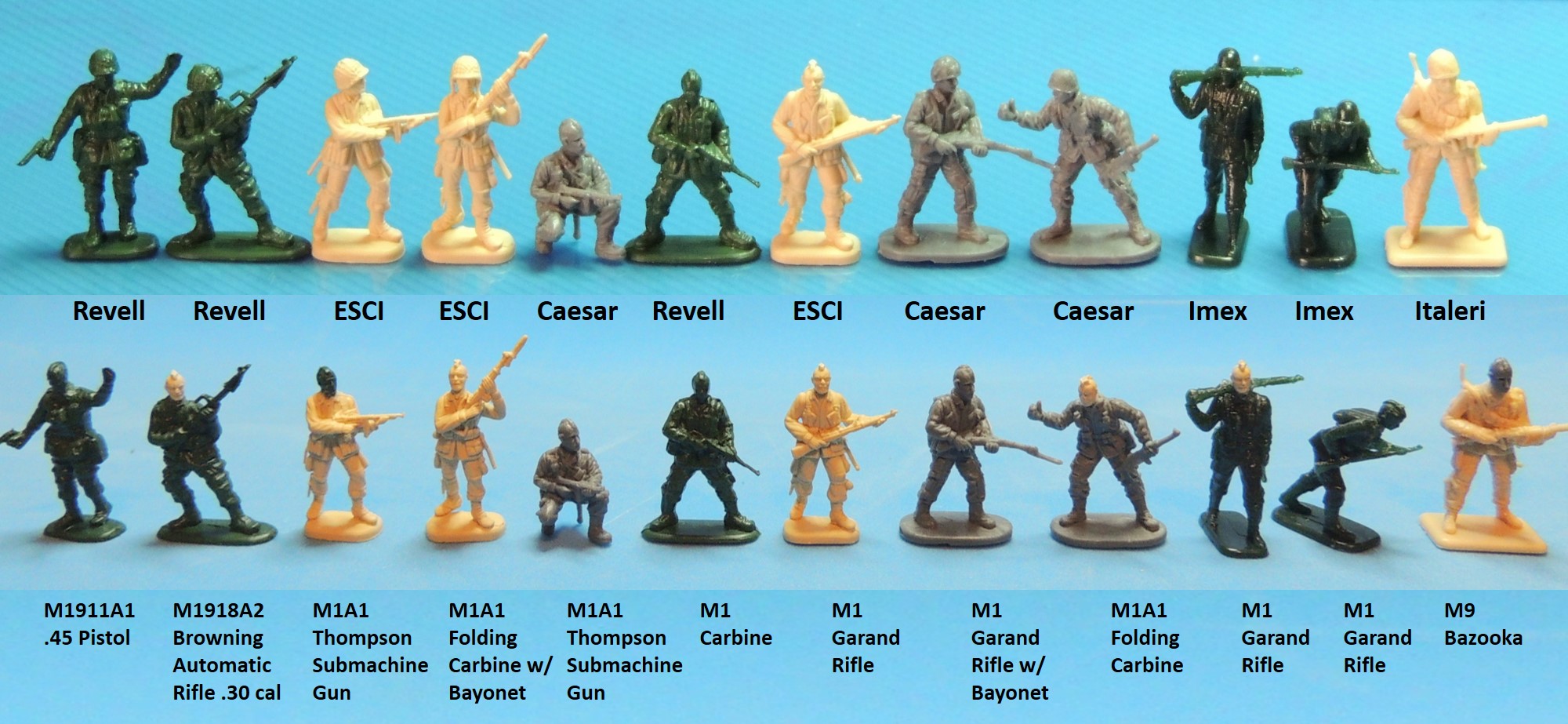
Weapons in 1/72 Scale
1. M1911A1 Colt .45 Pistol: The venerable seven-round, semi-automatic .45 caliber “Colt 45,” introduced prior to WWI, was issued to officers, non-commissioned officers, and machine gunners and was so effective that it wasn’t replaced until 1986, 75 years and several wars after its debut.
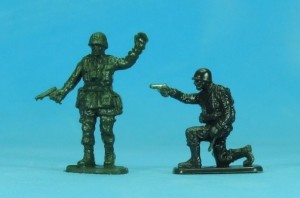
Every unit has an officer — always with binoculars and a pistol — and the various paratrooper sets offer different alternatives. However, only the Revell and Imex officers have a pistol in hand and the latter is clearly firing his in combat, leaving the Revell figure as the only choice. See photo inset at left. While it is impossible to determine at this scale what pistols the officers are really wielding, we must assume they’re the M1911A1 Colt .45 pistol, common with U.S. Airborne officers.
2. M3 Submachine Gun “Grease Gun”: The .45 caliber M3 Submachine gun was designed to be a simplified, cheaper ($20) replacement for the Thompson submachine gun. Commonly known as
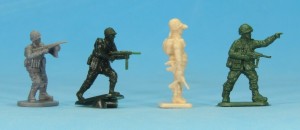
the “grease gun” because of its visual similarity to an actual mechanic’s grease gun, it was unjustly perceived to be less reliable than a Thompson, though its lighter weight (8 lbs.) made it popular among paratroopers who had to schlep loads of 100 lbs. or more on their backs.
For the most part, I succeeded in representing all the standard weapons used by U.S. Airborne troops shown in the Weapons Plate above. However, I failed to use a figure with the M3 “grease gun,” though there were four available. See photo inset above. Note how well-defined the weapon is on the Imex figure (second from left; click on the photo to enlarge). The proportions, detail, and sculpting on the Imex figures are dead-on.
3. M1 Garand Rifle: The semi-automatic, 8-round .30 caliber M1 Garand rifle replaced the 1903 Springfield rifle as the standard issue for U.S. troops in 1938, giving U.S. soldiers a distinct advantage over the slower German K-98 bolt-action rifle, which had become standard Wehrmacht issue in 1935. General Patton considered it “the greatest battle implement ever devised” and many soldiers preferred the M1 Garand’s greater range and stopping power over the M1 Carbine that was supposed to replace it. By the end of the war, over five million M1 Garands had been produced.
The various U.S. paratrooper sets included many figures with the M1 Garand rifle, reflecting the fact that it was the most common weapon used by U.S. Airborne troops. Thus, there were a number of choices and four of the selected 13 figures are carrying one, including one with the 10-inch M1 Bayonet attached. (See the Figure and Weapons Chart above.)
4. M1 Carbine w/ Wooden Stock: The semi-automatic, 30-round, .30 caliber M1 Carbine, which replaced the M1 Garand as the standard issue rifle in 1942, was intended to be smaller and lighter than the M1 Garand. At 35.5 in. and 5.5 lbs, it was, in fact, eight inches shorter and weighed four pounds less than the M1 Garand, making it well suited for paratroopers. With more than six million wood-stocked M1 Carbines produced, it was much more widely used by U.S. forces than its cousin, the folding stock M1A1 Carbine, of which only 150,000 were made. However, designed specifically for U.S. paratroopers, the M1A1 Carbine was more common among this group.
As with the M1 Garand rifle, the various U.S. Airborne sets offered a fair selection of figures equipped with the M1 Carbine. As noted, however, the folding stock M1A1 Carbine was more widely used by U.S. paratroopers so I selected only one figure carrying the M1 Carbine, the Revell figure (sixth from left), as can be seen on the Figure and Weapons Chart above.
5. M1A1 Carbine w/ Folding Stock: Identical to the M1 Carbine except for the folding metal stock, the M1A1 Carbine was 25 inches long when folded, fully 10 inches shorter than the M1 Carbine, making it an excellent weapon for the highly mobile paratroopers.
Given that the M1A1 Carbine was specifically designed for U.S. paratroopers, it is no surprise that at least 10 figures in the various U.S. paratrooper sets are equipped with it. The ESCI set alone includes five figures wielding this weapon. There are three figures with the M1A1 Carbine in the selected 13 — the ESCI (fourth from left) and Caesar (ninth from left) figures shown on the Figure and Weapons Chart above plus the Italeri figure (far right) with the M9 Bazooka, who carries the M1A1 Carbine on his back.
6. M1A1 Thompson Submachine Gun: One of the most recognized weapons in history, the M1A1 Thompson submachine gun was a favorite among the troops. Though generally only issued to squad leaders and officers in the regular army, it was widely used among paratroopers. Accurate up to 50 yards, it could fire its large .45 caliber rounds at a rate of 650 per minute, giving it devastating “sweeping” power within that distance. Though heavier than the M3 “grease gun,” the M1 Thompson submachine gun was more widely used.
The various figure sets provided a fair selection of figures wielding the M1A1 Thompson submachine guns, reflecting its wide use among paratroopers. As shown in the Figure and Weapons Chart above, I selected three — the ESCI figure (third from left), the kneeling Caesar figure (fifth from left), and the TQD Pathfinder figure, a picture of which appears in the previous post.
7. M1918A2 Browning Automatic Rifle (BAR): The fully automatic .30 caliber M1918A2 BAR, which replaced the M1918 used in WWI, was designed to be fired from the hip as an automatic rifle while moving forward in support of riflemen or from a stationary position as a light machine gun.
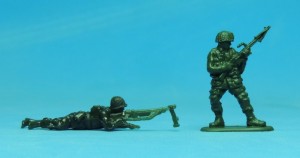
However, its paltry 20-round magazines greatly limited its effectiveness as a machine gun. While used by U.S. paratroopers, the BAR’s 20-lb weight and need to be reassembled after a jump made it an inconvenient — and therefore uncommon — weapon for Airborne troops. To reduce the BAR’s weight, experienced paratroopers often ditched the bipod, buttplate, and carrying handle, lowering the weight to 15 lbs.
There are only two BAR gunners in the 69 paratrooper poses available — one in the Imex set and one in the Revell set, as seen in the photo inset above. Thus, the Revell figure (on the right) was an easy choice since the Imex figure is prone firing the weapon, clearly in combat. The Revell gunner, who has not removed the bipod or carrying handle from his BAR, is presumably a novice. 
8. M9 Bazooka: The M9 Bazooka was a portable recoil-less, anti-tank rocket launcher that replaced the earlier M1 Bazooka in 1943. At 54 inches, the M1 Bazooka was unwieldy during jumps so the Airborne command specifically requested the M9 Bazooka, which could be broken down into two parts to make it more portable. By happy coincidence, the modification allowed engineers to make it longer, increasing range and accuracy.
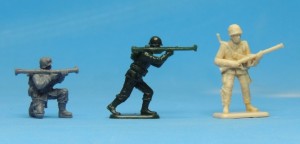
Considered the perfect infantryman’s anti-tank weapon, it could immobilize a tank with a solid, accurate hit. According to the conventional wisdom, the much-feared German 88mm Panzershreck was copied from a captured American bazooka.
The M9 Bazooka was common with U.S. Airborne troops so the set would have been incomplete without a figure carrying one. There were three potential figures with a bazooka, as can be seen in the photo inset above. However, two of them are actually firing the weapon so the Italeri figure was the only non-combat choice.
A passing glance at the Figure and Weapons Chart above quickly reveals that the Italeri figure (far right) is somewhat bulkier than the other 12, which gave me pause. In the end, I used it anyway. First, I rationalized that human height and girth varies significantly. It turned out that the figure is 26.4mm tall, which scales out to only 6’2”, totally within the acceptable range. He is crouching a bit, which means he’s actually taller. Secondly, the figure — huge as it is — represents the gentle but slow-witted giant often seen in Hollywood movies, including the one in the aforementioned Dirty Dozen. (To my mind, the all-time greatest Hollywood brute is Andre the Giant as the unforgettable Fezzik in The Princess Bride.) And finally, it makes sense that the biggest man in the unit would carry the M9 Bazooka, the heaviest weapon in the paratrooper arsenal, weighing 16 lbs — one pound more than the stripped down 15-lb BAR.
Browning M1919A4 Light Machine Gun
I intentionally did not include the Browning M1919A4 light machine gun in the Weapons Plate or in the discussion, as there were no figures carrying it in non-combat. However, four of the six sets include such a weapon and, for the sake of completeness, I’ve included a lagniappe photo of those four below. Referring strictly to the weapon and not the paratrooper, the ESCI machine gun (far left) has the most detail and best proportions, with the Revell and Italeri weapons closely behind. The Caesar machine gun (far right) is underscaled and has very little detail, though the paratrooper figure itself is excellent.

This concludes our lightning-fast survey of U.S. Army Airborne small arms. I hope you found the post informative. Stay tuned tomorrow for Part 4: The Finished Figures, with lots of photos of the painted figures. As always, comments, questions, corrections, and observations are welcome.

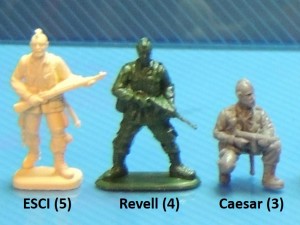 only exception, lacking sharpness in detail, though still not a bad effort. The ESCI, Revell, and Caesar sets each include one Pathfinder pose, fortunately with 5, 4, and 3 samples in each set, respectively. See photo inset at left. Thus, we have a total of 12 figures: three different ready-made figures and nine extra copies of those figures. To create 12 different figures with Mohawk haircuts, we take the heads of the nine extra copies and transplant them on the torsos of U.S. Airborne figures from the different sets.
only exception, lacking sharpness in detail, though still not a bad effort. The ESCI, Revell, and Caesar sets each include one Pathfinder pose, fortunately with 5, 4, and 3 samples in each set, respectively. See photo inset at left. Thus, we have a total of 12 figures: three different ready-made figures and nine extra copies of those figures. To create 12 different figures with Mohawk haircuts, we take the heads of the nine extra copies and transplant them on the torsos of U.S. Airborne figures from the different sets. 
